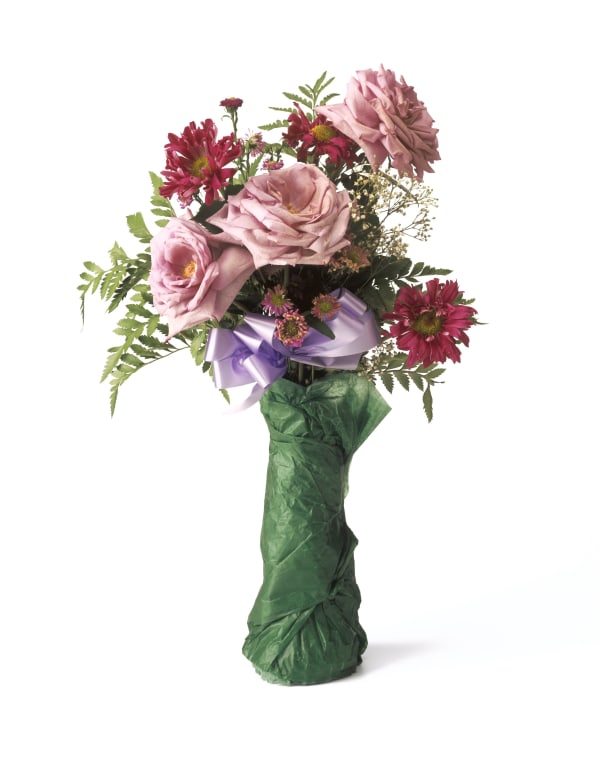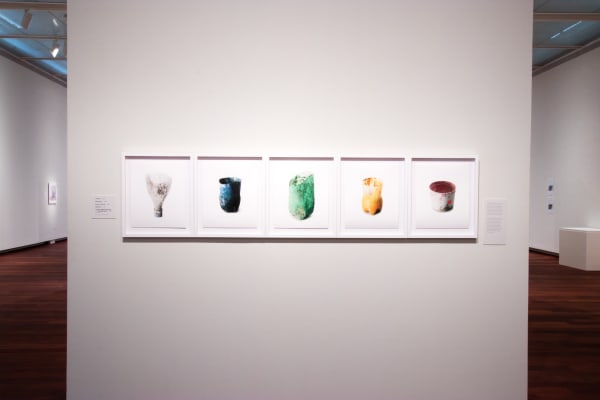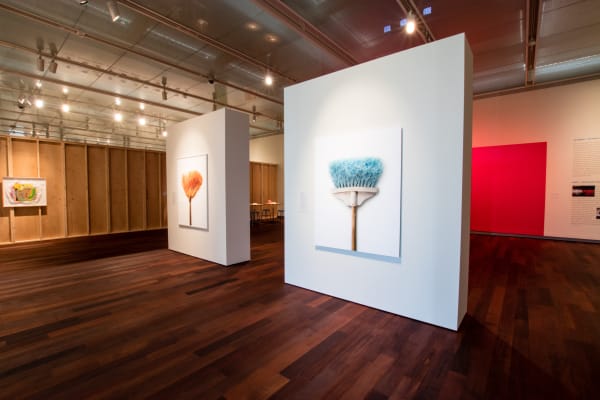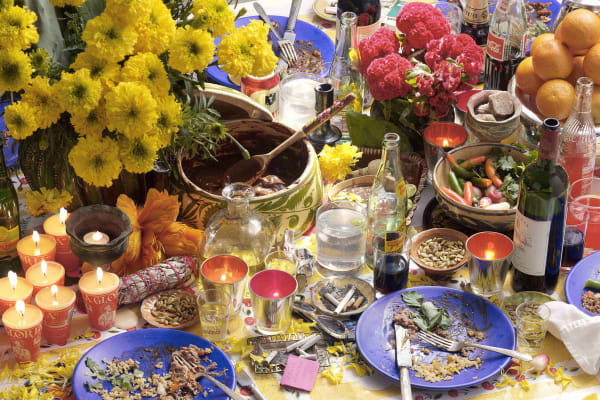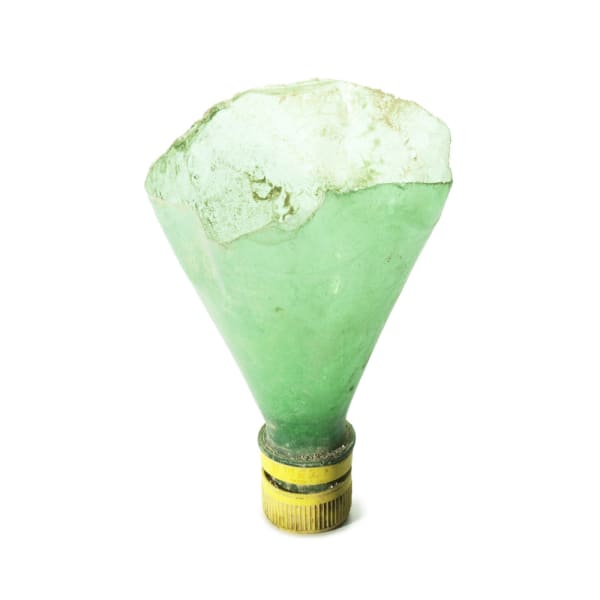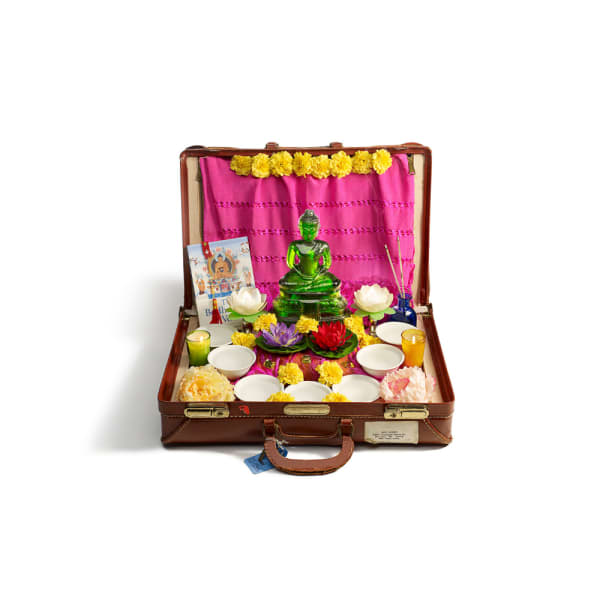-

-
Ruiz-Healy Art San Antonio presents Chuck Ramirez: Metaphorical Portraits, the fourth solo show with the gallery, of the late Chuck Ramirez (1962-2010) work. The exhibition focuses on the artist’s career-long exploration of bringing dignity to overlooked objects in a media saturated world. A diverse selection of works, Chuck Ramirez: Metaphorical Portraits probes viewers to reevaluate the significance of almost invisible objects and consider their impact on identity and culture.
While Ramirez’s work has maintained, if not, increased its relevance since his passing, certain collections like Quarantine are finding a particular global resonance in 2020. Alluding to the bleak and grief-stricken atmosphere of hospitals, the wilted floral arrangements emphasize the human experience in the face of illness and isolation.
Ordinary objects were a common theme in the artist’s work, as seen in Dust Collections and other Tchotchke. More humorous and playful than Quarantine, the series recontextualizes kitsch objects from the past. Works from Seven Days and Purse Portraits also offer poignant studies about communal gathering and material expressions of identity. These collections speak profoundly to present-day society where isolation and reflection have become widespread experiences. Works like Cocktail and Chaps from the 1999 series Long Term Survivor speak again to Ramirez’s ability to endow images with a myriad of conceptual themes.
Prophetically attuned to forces outside of himself, Ramirez’s 2007 Careyes deals with the American relationship to environmentalism as compared to regions like Mexico that have a custom of repurposing items until they are no longer functional. The artist stated, “In the United States ‘consumer culture’ permeates every aspect of our daily lives. Material objects are disposed of as quickly as they are acquired, with aesthetic value often trumping function or necessity...The practice of a ceaseless, compulsive consumption is something that is so ingrained in American culture that most often, we forget it is even there.”
-
QUARANTINE
-
Quarantine
Victor Zamudio-Taylor"Chuck Ramirez deals with the confluence of personal and social experiences through use of the grid and seriality. As an artist informed by the "objectness" of the image and issues germane to simulation, much of Ramirez' work employs an icon that is repeated and arranged serially. Like other native Tejano artists-Texans of Mexican-American origins-such as fellow San Antonio artists Jesse Amado and Franco Mondini-Ruiz, Ramirez' work may be inscribed in the tradition that Donald Judd forged when he moved to Marfa. Combining the lexicon of Minimalism with images drawn from Tejano and queer vernacular cultures, works such as Quarantine address key issues of contemporary experience.
Revisiting the Dutch vanitas genre, Ramirez arranges a series of images of floral displays in a grid. These large-scale digital prints of hospital floral arrangements reference the pain and grief of loss associated with terminal illness. Also recalling the works of Bernd and Hilla Becher, the depicted typology is objectified, purged of context by editing out narrative cues and background settings. Depleted and stark, the flowers convey, through seriality and metaphor, aspects of human experience as lived history. In contrast to artistic traditions in which everyday image is simply drawn from mass culture (from Warhol to Koons), Ramirez charges the simple, humble and banal with vital layers of signification."
Excerpt from Victor Zamudio-Taylor, "Quarantine," Políticas de la diferencia: Arte Iberoamericano fin de siglo, Consortium of Museums of the Valencian Community: Valencia, Spain, 2001.
-
"His mortality was no abstraction. For Chuck, death was a motivator, a commentator, a constant, something to make fun of, a background noise to be muffled with food and friends and laughter, but he never kidded himself. He knew time is short. He knew he was lucky."
Sarah Fisch, "Rocket Man," San Antonio Current, 2010.
-
long term survivor
-
"A 1999 show, “Long Term Survivor,” featured photographs such as Chaps and Cocktail (a day-of-the-week pillbox) that, like “Coconut,” owed something to identity-based art, acknowledging Ramirez’s status as a gay HIV-positive man. Like the best of that art, his work stretches beyond the personal, opening onto wider issues of physicality and mortality. The artist insists on the materiality of our world, the short shelf life of a shared consumer culture, without limiting meaning or feeling. For Ramirez, facing the fact that this is all there is—piñatas, garbage, Pop-Tarts, pills—argues not for the poverty or superficiality of our condition, but for its impossible sweetness and depth."
Katy Siegle, Artforum International Magazine, 2003.
-
dust collection and other tchotchke
-
"Ramirez stated that his paternal grandmother and family matriarch, Lydia Ramirez, was his muse. She was a devout Catholic and he made elaborate ofrendas, or altar offerings, in her memory for Día de los Muertos (Day of the Dead). Moreover, as he developed as an artist, he became more preoccupied with his heritage."
Elizabeth Ferrer, "Every Picture Tells a Story," All This and Heaven Too, McNay Art Museum, 2017. -
words
-
"I think he was gathering a lot of the inspiration from the people he was around. He really needed the energy of all those people. That’s why he traveled so much with Pat Smothers and all those guys because that was a whole other level of exposure to the world. And then coming home and gathering people and hearing people’s stories. When he died, he had relationships with people completely different from what I had ever known. He had so many relationships that were so, you know, tentacles out, that had something to do with the art world or nothing to do with the art world, but everybody who knew him felt connected."
Ethel Shipton, "Reminiscing About Chuck Ramirez," Chuck in Context, Ruiz-Healy Art, 2017.
-
seven days
-
Our America: The Latino Presence in American Art
E. Carmen Ramos, Smithsonian American Art Museum"Breakfast Tacos belongs to a series that explores how food, and the rituals surrounding it, can signify place, history, and personal identity. Here Ramirez juxtaposes references to three groups that have shaped Texas history: Mexicans, who comprise both native Texans and immigrants who arrived in the years before and after the Mexican Revolution (1910-20); Anglo settlers who led a movement - symbolized by by the Lone Star flag - to secede the region from Mexico; and German immigrants who settled in great numbers in a region now known as the German Belt. These group markers comment on the varying ways in which ethnically loaded references get absorbed into American popular culture. Miller Beer’s German roots may now be long forgotten, but Mexican - derived foods like tacos are still marketed as coming from across the border, a point alluded to by Ramirez’s inclusion of a miniscule straw hat (tortilla basket) emblazoned with the word Mexico. The Lone Star flag comfortably made the transition from national flag (of the Republic of Texas) to beloved state symbol. Breakfast Tacos reveals the hierarchy and history embedded in popular culture and also offers a glimpse at how Texans - presumably the invisible consumers of the meal - really live."
Excerpt from E. Carmen Ramos, Smithsonian American Art Museum, Our America: The Latino Presence in American Art, 2013
-
purse portraits
-
Purse Projects
Anjali Gupta"The San Antonio-based artist Chuck Ramirez began producing his Purse Portraits in 2005. Quite simply, Ramirez invited friends, mostly women, to surrender one of their most intimate possessions—their handbag—to be photographed. As the series progressed, Ramirez received more and more commissions. The result is an ongoing ontological study in physicality, staging and referential embellishment, both on the part of the surrogate figure (the purse) and the artist. In these works, elements of staging—of women literally curating the contents of their handbag and the artist arranging these elements to measured effect—grow more and more unmistakable.
For Ramirez, this observation is not a critique of his patrons and subjects but, rather, is very much in keeping with the tradition of portraiture. As mundane as it might initially seem, the purse is arguably the modern woman’s most private domain outside the corporeal self. To enter it without permission is a violation. (My mother taught me this rule as a child.) The physical form of the handbag references the female anatomy, and its clasp or closure is a reiteration of the feminine mystique. Its contents—staged or not—speak to matters of femininity, identity and, in the case of Ramirez’ recent work, the projection of the imagined self onto others."
Excerpt from Anjali Gupta, "Purse Projects," Art Lies, 2007.
-
lost and found
-
'Suitcase Portraits' by Chuck Ramirez Welcome Travelers to SAT
Wendy Weil Atwell"It’s hard to imagine San Antonio’s front door as the shadowy lower level of the San Antonio International Airport (SAT), teeming with cigarette and exhaust fumes, but that’s what greets almost everyone who arrives by plane. Now, when people step outside the baggage claim area and disperse in various directions, eleven “Suitcase Portraits” by Chuck Ramirez (1962-2010) will light their way. The 5-by-6-foot light boxes are spaced on the railings across the road that fronts lower level baggage claims for terminals A and B.
In each image, an opened suitcase is photographed against a white background, exposing its contents for all to see. What’s inside reads like a personality study. The portraits’ playful nicknames, given to them by the artist and friends, read like prompts for a short story, sparking the imagination: “Granny Goes to Vegas,” “Buddha,” and “Dancing Shoes.” Health obsessions, OCD orderliness, a fixation for cosmetics—the visual narratives reflect the wide variety of travelers juxtaposed together. As any row on an airplane suggests, the random process of air travel creates a bizarre permutation of seatmates.
Ramirez’s opened suitcases pique the inherent voyeurism in each of us and the effect is fun and fascinating – like taking an inventory of the strange life sitting next to you."Excerpt from Wendy Weil Atwell, "'Suitcase Portraits' by Chuck Ramirez Welcome Travelers to SAT," Rivard Report, 2015.
-
careyes and brooms
-
"The brooms and recycled objects photographs serve as ethnographical documents from several of my experiences visiting the Pacific coast of Mexico. While visiting friends I recognized a stark contrast between the pristine architecture of the area’s sprawling villas and vacation homes and the humble domestic items used to keep them clean. Handymen utilized cracked plastic bottles to hold paint for touching up walls; women scrubbed dirt floors with brooms worn down to nearly nothing. Although I had seen people like these many times in my travels across Mexico and the border region, it was not until I saw them against the contrast of the tourist oriented beach community, that I fully appreciated their industriousness."
Chuck Ramirez
-
-
Chuck Ramirez
American, 1962-2010Ramirez was a major force in the San Antonio art community before his untimely death in a 2010 cycling accident. A 2002 Artpace artist in residence, Ramirez’ work has been exhibited nationally and internationally. In 2012, The Smithsonian American Art Museum purchased Ramirez’ limited edition large-format photograph, Seven Days: Breakfast Tacos, for the institution’s permanent collection. During the winter of 2017, the McNay Art Museum exhibited the first significant survey of his work in the exhibition Chuck Ramirez: All This and Heaven Too. In 2019 the Blanton Museum of Art, Austin, TX acquired the large format Whatacup for their permanent art collection.
His work is in numerous permanent museum collections: The Smithsonian American Art Museum, Washington D.C.; The Blanton Museum of Art, Austin, TX; The Museum of Fine Arts, Houston, TX; The Pérez Art Museum (PAMM), Miami, FL; The San Antonio Museum of Art, San Antonio, TX; The European Museum of Photography, Paris, France; The McNay Art Museum, San Antonio, TX; El Museo Del Barrio, New York, NY; The Art Museum of South Texas, Corpus Christi, TX; The New México Museum of Art, Santa Fe, NM; Indiana University Art Museum, Bloomington, IN; Ruby City, San Antonio, TX; Orange County Museum of Art, Newport Beach, CA; Baltimore Museum of Art, Baltimore MD.
-
View the full series
-

Dust Collections and other Tchotchke 1995
Ramirez had his first solo exhibition in 1995 “Dust Collections and other Tchotchke.” In the show he presented a collection of toys, trinkets, and figurines, and uncomposed photographs of such... -

Long-Term Survivor 1999
First viewed during Chuck Ramirez’s solo exhibition at Artpace’s Hudson Showroom in the Spring of 1999. Since the AIDS crisis began, artists have responded overwhelmingly to this disease. The graphic... -

Quarantine 2000
'Chuck Ramirez deals with the confluence of personal and social experiences through use of the grid and seriality. As an artist informed by the “objectness” of the image and issues... -

Seven Days 2003-4
'In twenty-first century San Antonio tribal culture, it is not unusual for the inhabitants to gather in groups large and small in order to celebrate the temporary and intense nature... -

Words 2004
In addition to photography, Ramirez had a strong background in graphic design and was involved with the world of contemporary poetry, painting and music. Ramirez was a poet at heart... -

Purse Portraits 2005
'Chuck Ramirez began producing his Purse Portraits in 2005. Ramirez initially invited friends to surrender one of their most intimate possessions—their handbag—to be photographed. As the series progressed, Ramirez received... -

Careyes 2007
Statement by Chuck Ramirez: 'The brooms and recycled objects photographs serve as ethnographical documents from several of my experiences visiting the Pacific coast of Mexico. While visiting friends I recognized... -

Brooms 2007
'Chuck Ramirez’ Careyes and Brooms series are collections of medium-scaled photographs of brooms and paint sample bottles, respectively collected on trips to the remote Pacific coast of Mexico. Beautiful and... -

Lost and Found 2008
'Each image of the series, shows an opened suitcase photographed against a white background, exposing its contents for all to see. What’s inside reads like a personality study. The portraits’...
-
Chuck Ramirez: Metaphorical Portraits: San Antonio
Past viewing_room


